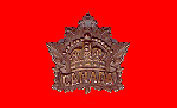

2768887
Richard White
Canadian Siberian Expeditionary Force.
(Infantry Detachment Siberian Draft)
b. 15 September 1878, St. John's Nfld.
Address on enlistment: Nain, Labrador
d. 24 October 1950
Enlisted: October 9, 1918
Age 40
Embarked Canada 11 Oct 1918
Arrived Siberia 26 Oct 1918
Appt. Lance Corporal 3 January 1919
Evacuated to Canada on compasionate
grounds (health) 1 March 1919
Discharged 15 June 1919He was recruited specifically as a
sled-dog handler and was employed
in that capacity in Siberia.Ed. Note. The badge pictured above is representative only. It is not known at this time which badge of the CEF Richard White wore.
Units listed as the Siberian Expeditionary Force are: B Sqn. Royal North West Mounted Police; HQ 16th Inf. Bde.; 259th Bn.; 260th Bn.; 16th Field Coy. Canadian Engineers; and the 20th Machine Gun Coy.
If anyone can help us with further information on this please contact us at:

Richard Whiteby Winston White
Winston White is writing a book about his father and the following
notes are taken from his work in progress. (November 14th. 2003)In 1912 Dad had moved from Hebron to Nain. He built a house and small store in Nain and another at Voisey's Bay, 30 miles to the south. The news of the Great World War in Europe, late arriving in northern Labrador, was worsening. Dad was now 39 but decided to enlist. He made arrangements with Edmund Winters to take over the trading post. His wife Ruth and little Ruth returned to be with her parents at Hebron and he left by coastal steamer to join up in early September.
He enlisted in the Canadian Expeditionary Force in Vancouver on October 9, 1918. His regimental number was 2768887. He served in Siberia and returned to Canada via Vladivostok and Hong Kong, China; he was discharged on June 15, 1919 with the rank of Lance Corporal. From his notes I found some of the soldiers' names he served with. Names such as Lt. Col. G.H. McDonell, DCM; Capt. J.G. Gauld, MC, Mimico, Ontario; Capt. W. Bentham of Brantford, Ontario; Raymond Massey; G. Markham of Irvington, NJ; and Stuart K. Seaman of Mombasa in what was then known as British East Africa.
In his column of October 1937, Joe Smallwood, "The Barrelman" wrote:
"One of the most interesting personalities I ever met was a man named Richard White. I had quite a number of chats with him and learned of his remarkable career. In 1917 he enlisted for war service. Men were wanted who were accustomed to cold climates, who understood dog driving and were accustomed to working on snowshoes. The idea was to send them to northern Russia." The Barrelman continued, "He was the means, during the War, of recruiting twelve Eskimo men on Labrador for service in the Newfoundland Regiment. They were all sharp-shooters and valuable work they did in France from a military standpoint."
I think one of those men was John Flagg of Nain. Some other Inuit I know who served in World War I included Fred Freida of Hopedale, Thomas Flowers of Nain, Abia Millik of Okak, The Ford relatives Abraham, Fred and John of Nain, William Shiwak of Rigolet and Manuel Pardy of Cartwright. I am not certain whether Richard encouraged any of those soldiers to enlist but they are some of the Labrador people who went away to fight. Dad and Manuel Pardy continued a life-long friendship. Mr. Pardy later came to Voisey's Bay and worked with Dad at the fox ranch. Throughout the years Dad shared what he could with his loyal friend and he helped Manuel through some tough times. After all, Manuel helped Dad in his time of need. Dick White never forgot that.
While he had been in Siberia with the Canadian Expeditionary Force Dad's wife Ruth had died in 1918, one of the victims of the terrible Spanish Flu that swept across the world. After the Moravian Mission ship Harmony left the Labrador coast that fall many Inuit and Settlers in northern Labrador were already sick. By the time it was all over that winter Makkovik, Hopedale, Nain, Hebron and Okak lost many of their villagers. The population of those settlements was 1273 in 1901; it was reduced to 860 in 1919. Okak was the hardest hit by the deadly influenza and one hundred and one people had to be buried in a mass grave. That community was reduced so much that the Moravians closed it in 1920.
Dad returned to Labrador by steamer as far as Hopedale, and took a smaller boat to Hebron to reunite with his little daughter Ruth. He packed up everything at Hebron. He and Ruth returned to Voisey's Bay and settled at his trading post and the fox farm which he called "the North Labrador Live Fox Depot." At that time it was, as he styled it "The Farthest North Fox Ranch in Eastern America. Specialties: Silver and White Foxes."
Further information on the Canadian Siberian Expeditional Force may be found on the following sites:
http://www.gwpda.org/memoir/cef.html
http://www.rootsweb.com/~canmil/siberia/siberia1.html